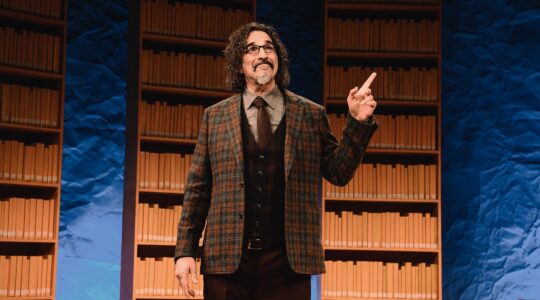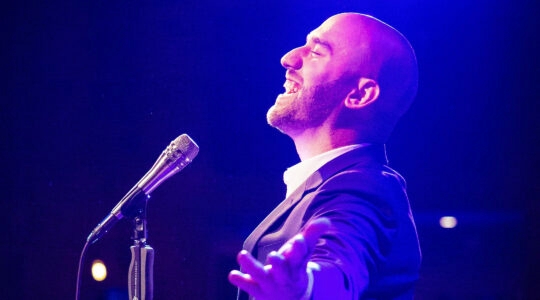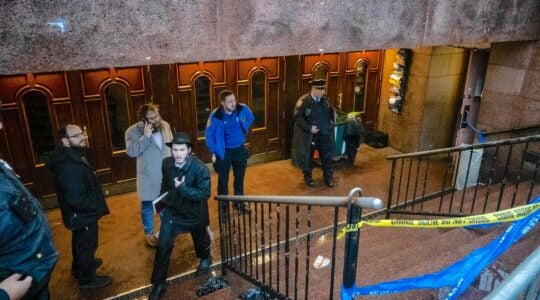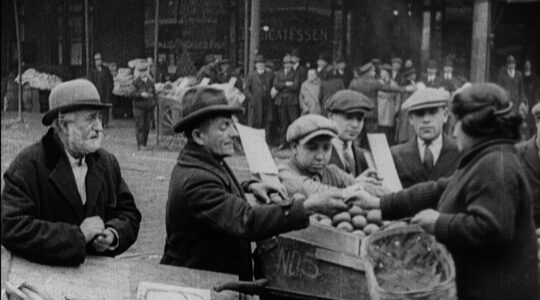Yes, the millennium is a Christian moment in time, but Jews were there for all of it. With all the lists marking the end of the epoch, thereís a Jewish story deserving to be told.We donít presume to have a person of the century or of the millennium, but we do have a Top 10 list of pivotal moments and pivotal generations that helped us get from there to here.
Letís be Jewish about this, and first remember the wagons that were lost along the way. Who remembers the 350-year Kuzari Jewish kingdom, near the Caspian Sea, that fell in 1016? We remember Haman and Hitler, but who remembers Bogdan Chmielnicki? Between 1648 and 1656, he killed 100,000 Jews the old-fashioned way: without trains, automatic weapons, gas or a mechanized army. There are still statues to him in Ukraine.Who remembers the lost dreams of the thousands of Jews who in their spiritual malnutrition followed more than 20 false messiahs? What of the denominations, such as the Karaites, that entered this millennium but leave it in oblivion? Then there are the great curiosities, such as Ho Chi Minhís 1946 offer to David Ben-Gurion, to establish a Jewish government-in-exile in Vietnam?Here are 10 millennial episodes, somewhat chronologically, that were more lasting.10. The CommentatorsThink of the world at the dawn of the last millennium: the Dark Ages on one side, the Crusades on the other. Poor Jewish homes had literally the earth for a floor. There were no books; it was centuries before the printing press. Hand-written copies of Jewish holy texts were rare; literature almost unheard of. The European Jewish world was without the cerebral intensity that later characterized it. Then Rashi (1040-1145), a French winemaker, inked a sentence-by-sentence commentary on the Torah and Talmud. Just 35 years after Rashiís death, Rambam (Maimonides, 1135-1204) came along, then Ramban (Nachmanides, 1194-1270), and 800 years later, these early millennial commentators are still the essence of Jewish religious intellect. When the first Jewish book came off the printing press in 1444, there was Rashi on page 1.9. The Wandering JewsBenjamin of Tudela, in the eight years prior to 1173, traveled from Spain to Constantinople to Yemen to India, up into northern Asia and back to Spain, while keeping a detailed journal about the Jews he met in those distant times and places. Not long after that, in the 1280s, Marco Polo wrote of Jewish merchants and cultural influences in China. Immigration to China seemed like the way to go. China wasnít anti-Semitic: It had no Christian or Muslim baggage, was a place of culture and commerce, and enough of a Jewish community came together in Kaifeng to build a synagogue there in 1163. It was a choice that served Jews well for centuries. Tudela wandered when inspired, but the early centuries of the millennium saw Jews expelled from hundreds of towns, fiefdoms, regions and empires, creating an unprecedented traffic of refugees. Thousands of Jewish communities became the Eleventh Lost Tribe. But the resilience of our medieval grandparents to survive in the oddest alien cultures kept our history moving along.8. The Safed MysticsBack in the 1100s, when our peripatetic Benjamin of Tudela visited Safed, there wasnít a Jew in town. What happened in Safed, though, for a few years in the mid-1500s, is still being felt in every Jewish town in the world. A small community, centered around the leading kabbalist, Isaac Luria (the Ari), his main disciple Chaim Vital, and Joseph Caro (who compiled the Shulchan Aruch Code of Law), created the foundation of modern Jewish mysticism that still echoes from elite yeshivas and graduate schools to pop Judaism classes for the masses. Every Friday night, in every denomination, from chavurot to chasidim, from Manhattan to Morocco to Argentina, Jews sing, even dance, to ìLecha Dodi,î written by Safedís Shlomo HaLevi Alkabetz. A contemporary of the Ari, he put immortal words to the way they greeted Shabbat in Safed at sundown. It was a singular 16th century village, but the mystical advances there became international and enduring.7. Early ChasidimA strange spiritual concept emerged in the 1700s ó ìthe pursuit of happiness,î Jefferson called it. After centuries of authoritarianism, history was discovering a human dimension; even serfs had souls, even Jews dared to want joy. In the forests of Europe, the Baal Shem Tov emerged with a populist theology that elevated love for a fellow Jew, the idea that any Jew, even the illiterate, could approach God through joy and sincerity. Gone was pomposity; God was transmitted through stories, fables, table-thumping songs. The Baal Shem Tov taught his chasidim a spiritual humility: What do we really know? A beggar might be Elijah; a lumberjack in an inn might be the Messiah himself. It was said of the Baal Shem, ìHe made [Jews] dream so much that they describe him as a dream.î He enraged the mainstream Jews, but 300 years later, heís universally loved, from Satmar to Jewish Renewal, across the Jewish rainbow. Anyone ever touched by Shlomo Carlebach, or a Chabad emissary on a college campus or at a seder in Nepal, is getting a second-hand kiss from the sweet Baal Shem; a chain letter of love from the 1700s.6. Yiddish ArtistsItís hard to imagine, with Jews now a foundation stone of every art form from music to theater to literature, that as late as the 1880s, Jewish art barely existed beyond religious life. Yes, there was music, but for weddings and prayer. There were chasidic stories, but for religious inspiration. There were journals, but more fact than fancy. There was poetry by Yehuda HaLevi (1075-1141), in Spanish Toledo and Cordoba, and compilations of rhyme and legends, particularly in Sephardic countries, based on Arabic models, but nothing like the sustained creative movement in Yiddish and Hebrew spurred by the Haskala in the generation between the 1880s and the First World War. From Byelorussia to the Bronx, creative writing and journalism burst forth from hundreds of artists like Mendele Mocher Sforim, Sholom Aleichem, Y.L. Peretz and Chaim Nachman Bialik. The new Yiddish newspapers and magazines were their cradle. They wrote about everything: Jewish horse thieves, pogroms, Zionism, adult romance, immigration and marrying off a daughter. They took all of Jewish life seriously, transforming what seemed to be ordinary into art. Nothing Jewish bored them. A Yiddish theater emerged, and composers such as M. Warshavsky, Abraham Goldfadden and others were writing ìOyfen Prepitchikî and operettas that sent Jews home humming ìRozhenkes Mit Mandlen.î Before radio and recording, such music somehow became instant favorites of Jews from Brooklyn to Paris to the Carpathian Mountains and the Baltic. The spiritual grandchildren of this generation followed in artistic careers that didnít even exist 120 years ago but are now quintessentially Jewish, changing Western culture in the process.5. Coming To AmericaNearly 2 million Jewish immigrants entered the United States in the great waves beginning with the 1880s. They came here with not much more than spirit and a satchel, and despite miserable poverty and discrimination, raised children who within one generation laid the foundation for the greatest Golden Age in the history of the diaspora. Street peddlers dropped enough nickels and dimes into pushkes to build an infrastructure of educational, health and self-help organizations that created our Pax Americana. Despite an outside world that afforded them little dignity, this generation raised Jewish children with a pride and a love that remains legendary.4. Early ZionistsWhen Ahad Haíam was born near Kiev in 1856 the idea that heíd live his last years in Tel Aviv were fantasy, if not lunacy. Nevertheless, he was among the great confluence of Zionist leaders and writers that set an idea in motion, leading to Israelís rebirth in 1948. Where exactly did it begin? The Bilu movement, which settled pogrom survivors in Palestine in 1882? The Hovivei Zion? Of course, there was Herzlís awakening in the 1890s. But from out of the Pale and centuries of political impotence, several men were born in remarkable proximity: David Ben-Gurion (1886); his ideological arch-rival, Zeíev Jabotinsky (1880); men in sweat-drenched clothes who worked and died for the land, such as Joseph Trumpeldor (1880); and men in suits, such as Chaim Weizmann (1874). The list of early Zionist leaders, of course, is much longer than this, and the list of the less-publicized men and women from this same generation, who actually created the critical mass of population, paving the streets and planting the groves, is longer still. Itís impossible to imagine 1948 without the boys of the 1880s.3. Holocaust SurvivorsDonít insult Holocaust survivors with speculation about the millenniumís end of days; Europeís Jews met the apocalypse in the 1940s. Survivors were orphaned, homeless, penniless, humiliated, physically and mentally injured, and witness to the darkest truth that civilization couldnít be trusted ó not the doctors, not the arts, not the politicians, not the neighbors. Elie Wiesel said that survival itself ìwas sheer luck. Nothing else. It wasnít heroism, or initiative, or intelligence, just sheer chance.î But after the war, well, that wasnít chance; they had a choice: Survivors could have responded like the blinded Samson, to bring down the pillars destroying the world and themselves. Instead, they brought children into the world, built schools, built synagogues, built Israel, gave remarkable amounts of charity, gave witness, and gave thanks.2. 20th Century WomenHas there ever been a greater religious and social revolution in any century such as Jewish women achieved in this last one? There are now women rabbis in the Reform and Conservative movements; the concept of the bat mitzvah has attained mainstream status; the Orthodox created the Bais Yakov school system, Stern College for Women and graduate programs for religious study. Even in the chasidic world, there are more than 7,000 Chabad women who are considered emissaries and on the front lines of outreach in ways equal to their husbands. Unlike their Jewish sisters who used the new freedoms to assimilate, the religious Jewish woman made the case that the problem with the old ways wasnít that Judaism demanded too much but that it didnít demand enough.1. The Jewish SoldierItís not that Jews didnít fight back in the years between the Maccabees and 1948. Jewish self-defense groups turned back pogroms and formed regiments that revolted against Russia. Some 11,000 Jews assisted the Allied victory that wrested Palestine from the Turks. A young Zionist woman, Hanna Senesh, parachuted behind German lines to assist Jews. And there were revolts even in concentration camps. In the Yishuv, the Haganah was formed in 1920, the Irgun in 1931, the Palmach in 1941. Nevertheless, the generation of Jewish soldier in the 28 years between the War for Independence and Entebbe transcended the heroic and entered the biblical. Beyond the military success in those long ago June days and Yom Kippur were personal stories of remarkable courage, sacrifice and beauty. The victories not only delivered a massive dose of pride to Jews around the world, even behind the Iron Curtain, but delivered respect to the Jew, even if that respect was grudging. If we had a Churchill, the battle for Jerusalem in 1967 was Israelís finest hour, as soldiers kissed the Wall with the shofar blowing on the Temple Mount. The newspaper clips are yellowed now, as is much of the jingoism, but once there was a time.
The New York Jewish Week brings you the stories behind the headlines, keeping you connected to Jewish life in New York. Help sustain the reporting you trust by donating today.




